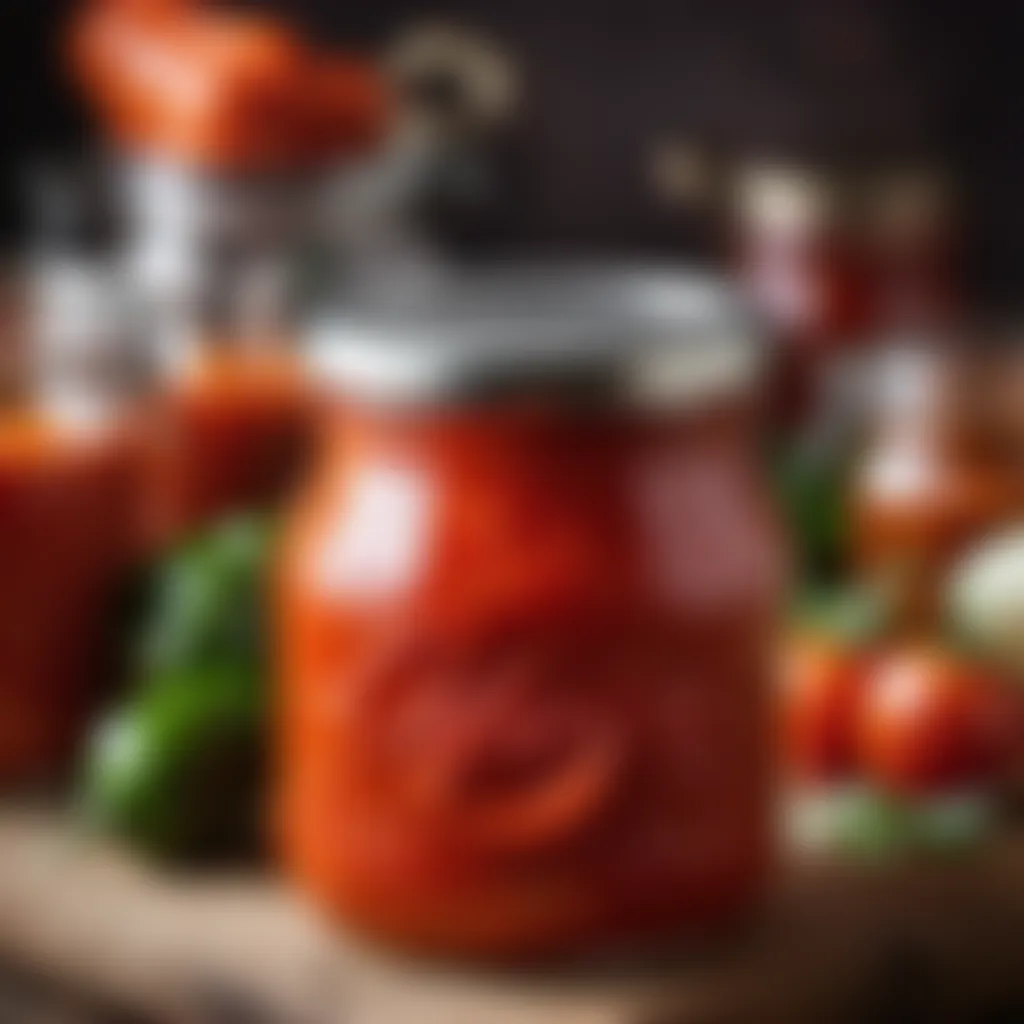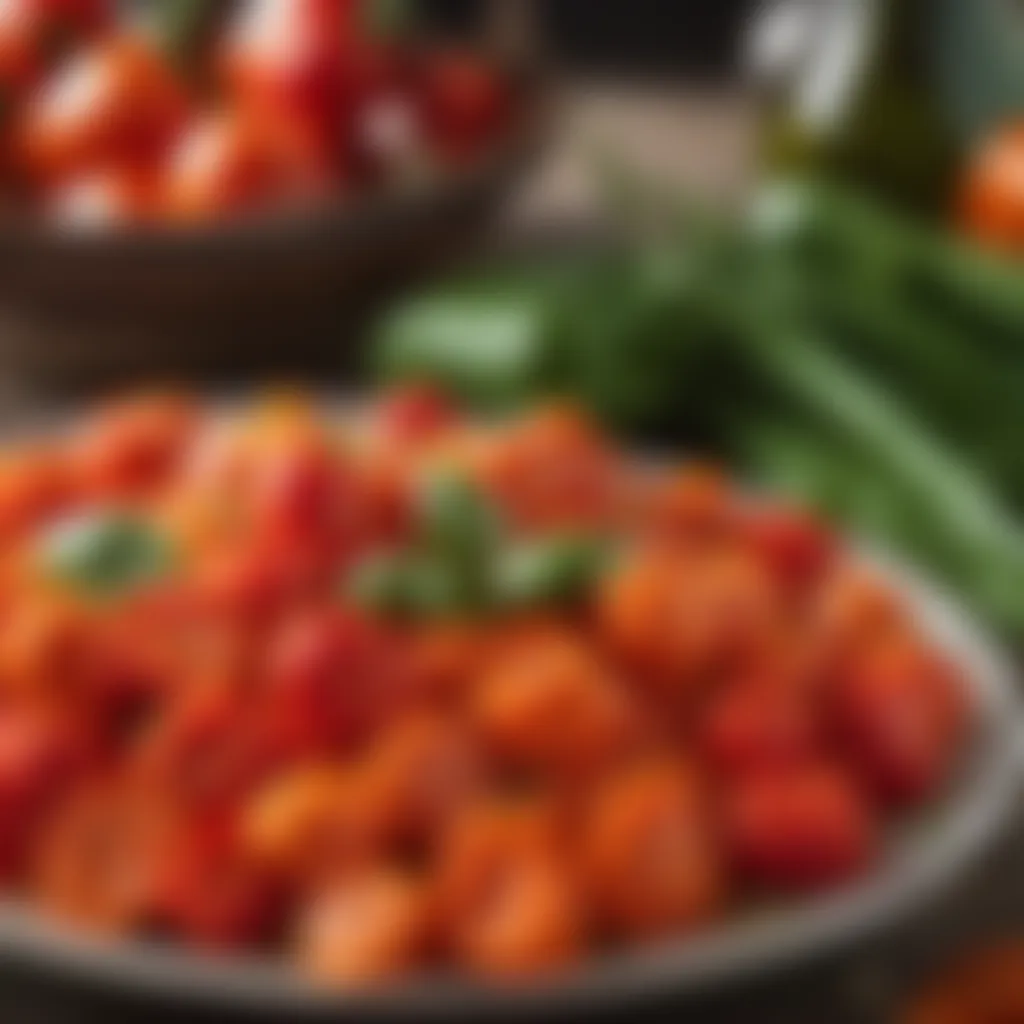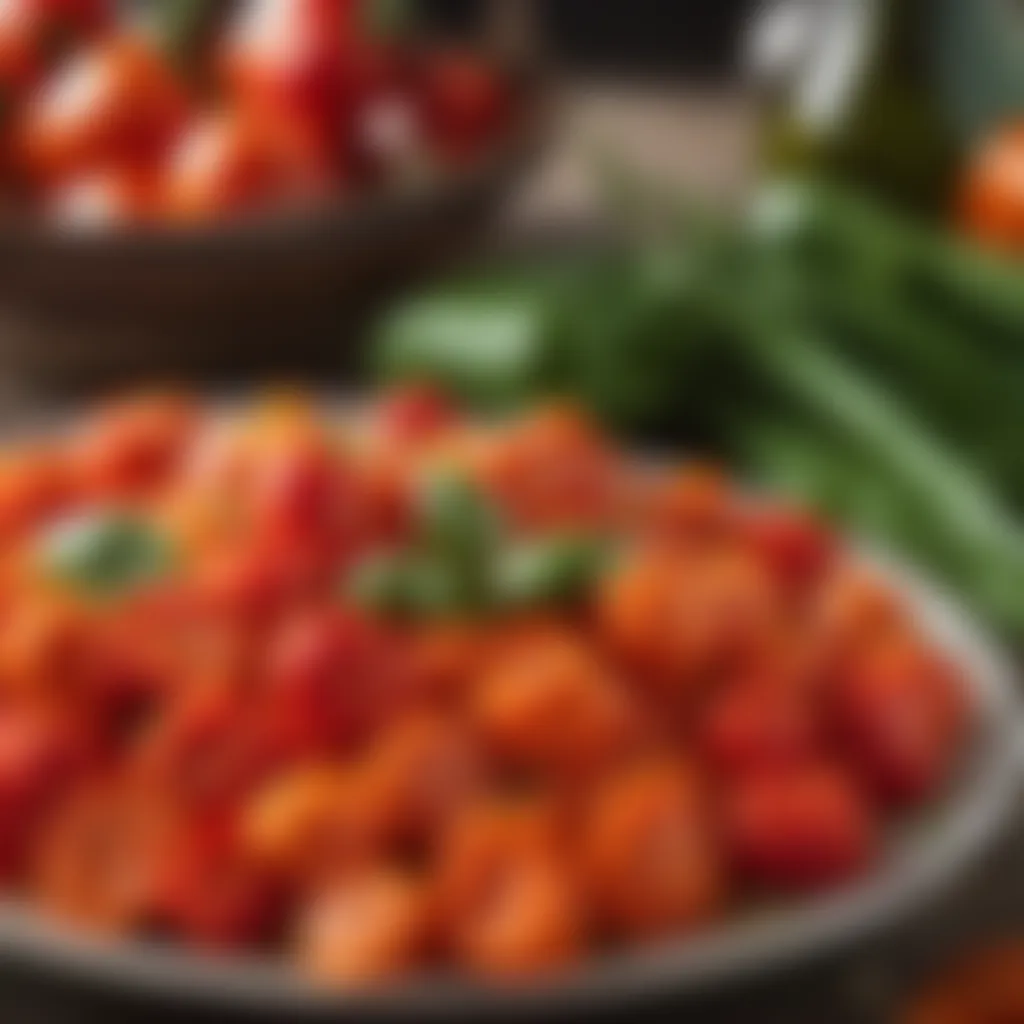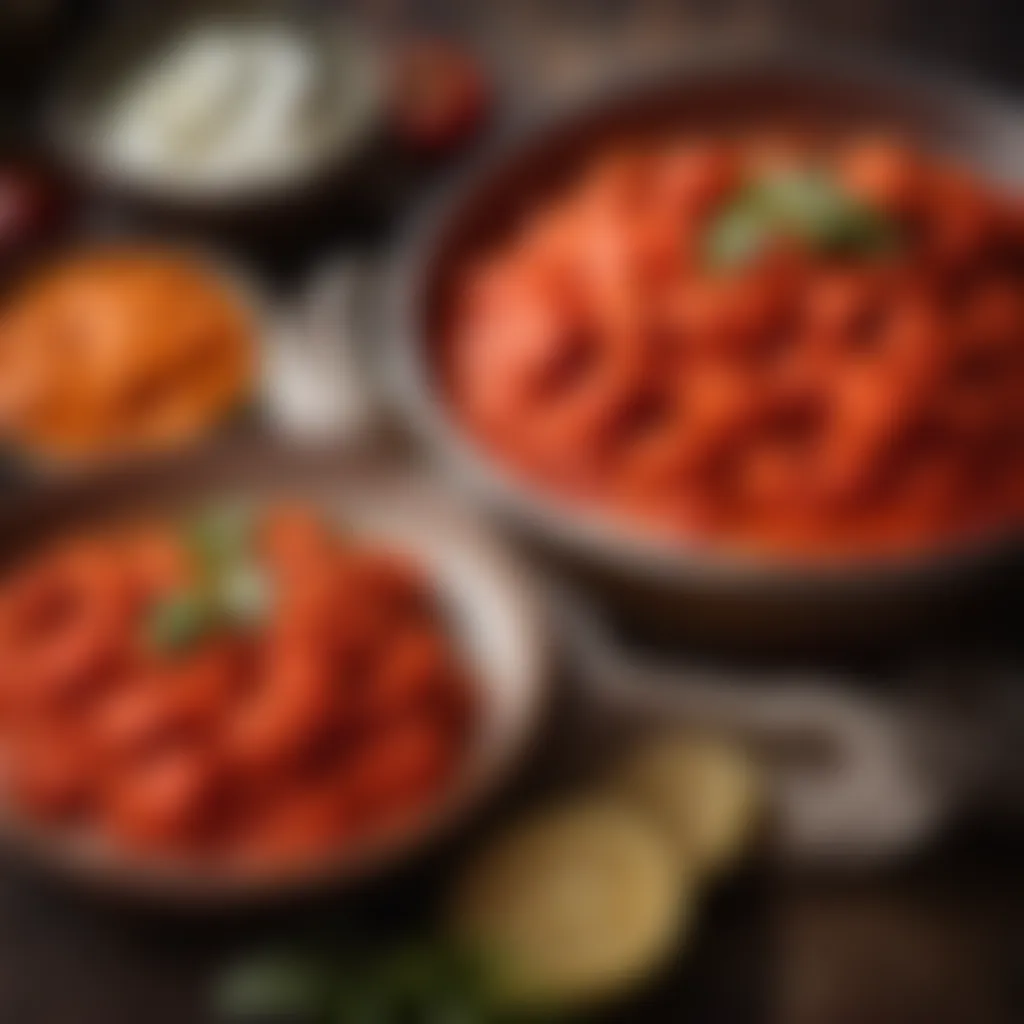Exploring the Richness of Ajvar: A Culinary Journey


Intro
Ajvar is more than just a spread; it’s a robust ticket to the culinary essence of the Balkans. Originating from countries like Serbia, Macedonia, and Croatia, this delightful condiment conveys a sense of homecoming, family gatherings, and shared meals. Imagine the smoky aroma of roasted peppers mingling with garlic and eggplant, evoking memories of summer barbecues and long dinners with loved ones. Whether you're slathering it on warm bread, tossing it with pasta, or serving it alongside grilled meats, Ajvar possesses an endearing ability to enhance any dish with its rich, vibrant flavor.
In this guide, we'll dive into every aspect of preparing Ajvar, providing jumpstart tips, tricks, and insights along the way. We'll cover the essential ingredients that form the foundation of this spread, precise steps for preparation, various cooking methods, troubleshooting pitfalls, as well as technical specifics to ensure your Ajvar comes out perfect every time.
So, let’s roll up our sleeves and whip up a batch of this savory delight that is sure to become a staple in your kitchen. Prepare to be amazed as we journey through the delicious world of Ajvar!
Ingredients:
To bring forth the true essence of Ajvar, the following ingredients are necessary:
- Red bell peppers – 1 kg (about 2.2 lbs)
- Eggplant – 500 g (about 1.1 lbs)
- Garlic – 4 cloves
- Olive oil – 100 ml (about 0.4 cup)
- Salt – 1-2 teaspoons (adjust to taste)
- Vinegar – 2 tablespoons (for tartness)
- Chili pepper – optional, to taste
- Black pepper – to taste
This mix of ingredients forms a luscious base for your Ajvar, ready to be transformed into a flavorful spread that can complement various dishes.
Detailed Instructions:
1. Roast the Peppers and Eggplant
First things first. Roasting is key to bringing out that rich, smoky flavor.
- Preheat your oven to 220°C (428°F).
- Place the whole red bell peppers and eggplants on a baking sheet.
- Roast for about 30-40 minutes, turning occasionally until the skin is charred and blistered. The sweet smell will fill your kitchen, and you may even feel a tinge of excitement as you get closer to crafting Ajvar.
2. Skinning and Seeding
Once roasted, allow the peppers and eggplant to cool for easy handling.
- Remove the charred skin by gently peeling it off.
- For the peppers, cut them open, discard the seeds, and keep the flesh.
- For the eggplant, slice it open and scoop the soft flesh out with a spoon, leaving behind any unwanted seeds.
3. Blend the Ingredients
In a food processor or blender, place the roasted pepper and eggplant flesh along with garlic, salt, and chili (if using).
- Blitz until you achieve a smooth or chunky texture depending on your preference.
4. Finishing Touches
- Heat olive oil in a pan over medium heat, then pour in the blended mixture.
- Stir in vinegar and adjust the black pepper and salt to taste.
- Cook for another 10-15 minutes, stirring frequently until the mixture is thickened and deeply flavorful.
5. Storage
Let the Ajvar cool before transferring to sterilized jars. Seal them well. If done correctly, it can last for up to 3 months in the refrigerator.
Ajvar can be enjoyed in countless ways: spread it on bread, layer it in sandwiches, serve it with grilled meats, or toss it through pasta for a zing of flavor.
Technical Aspects:
It’s important to note a few technical aspects throughout this procedure to ensure success:
- Roasting Temperature: Always keep your oven at 220°C (428°F) for optimal charring without burning.
- Timing Specifics: Ensure you roast adequately—don’t rush this part, as it’s the heart of the flavor!
- Texture Preference: Adjust blending time based on how smooth you prefer your final product.
Cooking Process:
Sequential Steps:
- Preheat oven and roast the vegetables until skin is blistered.
- Allow cooling, then skin and seed the roasted items.
- Process ingredients until desired consistency is reached.
- Cook mixture on medium heat with oil and seasonings, stirring continuously.
- Transfer to jars and properly seal for storage.
Troubleshooting Tips:
- Too Thin? If your Ajvar appears thin, cook it a bit longer to thicken it up.
- Too Spicy? For a naturally sweet touch, consider adding a pinch of sugar.
- Burnt Flavors: If you accidentally burn the mixture, add another fresh batch of roasted vegetables to help balance the flavor.
By embracing the rich tapestry that is Ajvar and engaging with these techniques, you not only elevate your cooking skills but also craft something deeply satisfying and layered with tradition.
Intro to Ajvar
Ajvar is not just a condiment; it's a celebration of flavors that has adorned Balkan tables for generations. At its core, ajvar brings together simple ingredients, transforming them into something extraordinary. It embodies a blend of traditional cooking practices and seasonal produce, making it an essential part of Balkan cuisine. Understanding ajvar is crucial for anyone looking to explore diverse culinary traditions and expand their cooking repertoire.


Historical Context
The roots of ajvar trace back to the agricultural communities of the Balkans. Initially, this spread was primarily a means of preserving the bountiful harvests of peppers and eggplants, especially during the late summer months. The process involved roasting, peeling, and slowly cooking the vegetables, all aimed at enhancing their flavors and maximizing their shelf life.
In the early days, various regions took pride in their own versions of ajvar, leading to the birth of many family recipes handed down through generations. Some might say it’s in the DNA of the people, as each household adds a personal touch, perhaps a hint of spice or a unique cooking method. Historically, ajvar was considered a peasant dish, but as it gained popularity, it earned a spot on the tables of the well-to-do!
Cultural Significance
Ajvar serves as more than just a tasty treat; it reflects the culture and unity of the Balkan people. It’s often seen during gatherings and celebrations, symbolizing hospitality and warmth. Friends and families gather to enjoy meals with ajvar, often those who have their roots in various regions share their unique takes on the recipe. This fosters a sense of community and tradition.
Interestingly, the act of making ajvar is itself a social event. People come together, whether it’s to roast peppers outdoors or share a meal made richer with the addition of this spread. As a result, it’s often associated with local festivals and home-cooked meals, bridging generations and preserving culinary heritage.
Ajvar represents more than just flavors; it narrates a rich story about culture, community, and the simple joys of food.
In everyday terms, it’s not uncommon to find ajvar accompanying barbecues or family feasts, standing proudly alongside grilled meats or enjoyed as a simple spread on fresh bread. It's a testament to the versatility and appeal of ajvar, allowing it to transcend its humble origins while maintaining its deep-rooted significance.
Key Ingredients
In crafting a vibrant and flavorful Ajvar, the role of key ingredients cannot be overstated. Each component not only contributes to the unique taste profile but also ensures the final dish resonates with authenticity and love for Balkan cuisine.
Bell Peppers
At the heart of Ajvar are beautiful bell peppers, often seen in vivid hues of red and yellow. These peppers are not just a mere filler; they impart a sweet, smoky flavor that serves as the backbone of this spread. When selecting bell peppers, aim for the ripest ones you can find. They should be firm to the touch, with smooth skin and a rich aroma.
Moreover, the type of bell pepper you choose can significantly affect the taste. Red bell peppers tend to be sweeter, while a mix with green peppers can add a touch of bitterness, crafting a more complex flavor.
Eggplants
Eggplants are another star player in the Ajvar ensemble. They bring a creamy texture that helps balance out the sweetness of the bell peppers. Choosing the right eggplant is key—look for the ones that are glossy and heavy for their size. A fresh eggplant should yield slightly to pressure but not be overly soft. Roasting eggplants before blending enhances their smoky flavor, elevating the entire dish.
Garlic
Garlic, a staple in many Mediterranean dishes, does wonders in Ajvar by adding depth and a pungent kick. When using garlic, be cautious—fresh, raw garlic can be very potent, so it's wise to start with one or two cloves, adjusting according to your personal taste. Roasting the garlic before adding it to the mix can mellow its intensity, delivering a beautifully layered flavor to your Ajvar.
Spices and Seasoning
Spices are the unsung heroes of any culinary creation, and Ajvar is no exception. Commonly, a blend of salt and pepper is sufficient, but adding a pinch of smoked paprika can amplify the smokiness further, creating a more robust flavor profile. Some recipes might also call for a dash of vinegar or lemon juice for brightness, balancing the sweetness from the peppers. Remember, the beauty of Ajvar lies in its adaptability. Experimenting with different seasonings could yield a version that suits your palate perfectly.
Summary: The key to an outstanding Ajvar lies in fresh, high-quality ingredients. Bell peppers, eggplants, garlic, and a thoughtful selection of spices work in harmony to create a delightful spread that delights the taste buds.
Preparation Techniques
Preparation techniques are the backbone of creating Ajvar that sings with flavor. This phase focuses on how to coax the best out of your ingredients, ensuring that each bite tells a story. Knowing how to prepare ingredients correctly impacts the overall taste and texture of the final product. When you're aiming for that perfect balance of smokiness, sweetness, and richness, the methods you choose really matter. The way you handle those bell peppers and eggplants can elevate your Ajvar from standard to stellar.
Roasting the Peppers
Roasting is truly where the magic begins. The essence of Ajvar lies in its roasted bell peppers, which impart a tantalizing flavor profile. To get started, you’ll want to select vibrant, ripe peppers—red or yellow varieties work wonderfully. Wash them thoroughly and then toss them onto a baking sheet. Placing them under high heat—around 450°F or 232°C—will help blister their skin and release those flavorful juices.
Keep a close eye on them; every ten minutes or so, turn them to ensure even cooking. Once the skin is nicely charred, it's time to wrap them up in a towel or put them in a paper bag. This traps steam and makes peeling much easier.
Prep tip: Don’t rush this step; the richer the roast, the deeper the flavor. There’s a reason why patience is considered a virtue in cooking!
Blending Process
After roasted, let the peppers cool a bit before peeling off the skins. The blending process is next, and this is where you can really customize your Ajvar. Throw those roasted peppers into your blender with some eggplant, garlic, and spices. For a smooth texture, blend until everything is harmonious, but for a bit of rustic charm, leave some chunks intact.
Consider adding olive oil gradually during blending. This enriches the spread, giving it a silkier mouthfeel. Be sure to taste often; adjust the salt and spices as you go. The blending process isn’t just about mixing; it’s about building the right flavor balance.
Cooking Time and Temperature
Now, let’s discuss cooking time and temperature. Once blended, the mixture needs to be simmered on low heat, allowing the flavors to meld together beautifully. Aim for a cooking time around 30 to 45 minutes on medium heat. This step not only thickens the Ajvar but also intensifies its flavors. Stir regularly to prevent sticking and to ensure even cooking.
You’re looking for a rich color and a paste-like consistency at the end. Keep in mind that Ajvar can still burn, so be cautious with the temp. A gentle simmer transforms a simple mix into a robust spread worthy of your table. Thoughtful attention during this stage can save you from unpleasant burned bits that ruin a perfectly crafted condiment.
"The care you put into preparation reflects in the joy of eating."
Variations of Ajvar
Ajvar is not just a single recipe; it embodies a spectrum of flavors and nuances that cater to diverse palates and culinary styles. This versatility is one of its most appealing attributes, allowing home cooks to tailor the spread to match personal preferences or regional traditions. Here, we will explore three prominent variations: Classic Ajvar, Spicy Ajvar, and Smoky Ajvar. Each variation presents its own unique character while still celebrating the core essence of this beloved Balkan spread.
Classic Ajvar


Classic Ajvar holds a special place in the hearts of many. It’s the traditional interpretation, often made with a simple formula of roasted bell peppers, eggplants, garlic, and a dash of salt. The ingredients are roasted until their skins are charred, enhancing their natural sweetness.
The result? A smooth, vibrant red spread that can easily stand alone as a dip or showcase its culinary prowess alongside bread or meats. For those looking for an authentic taste of the Balkans, this is the variation to try. Its ingredient list remains uncomplicated, making it approachable for even novice cooks.
"Classic Ajvar is like a hug in a jar—warm, comforting, and undeniably flavorful."
Stepping outside the realm of mere taste, Classic Ajvar also reinforces cultural connections. Many families have their own heirloom recipes passed down through generations, making the act of preparation a family affair filled with stories and memories.
Spicy Ajvar
If Classic Ajvar is a warm embrace, Spicy Ajvar is a bold shake-up for your taste buds. This version includes the same foundational ingredients, but the addition of hot peppers elevates it to another level of flavor. Jalapeños, cayenne, or even a mix of local hot varieties offers the heat that spice lovers crave.
This variation is not merely about adding heat; it's about depth and complexity. The warmth from the peppers complements the sweetness of the roasted bell peppers, creating a dish that not only brings heat but layers of flavor. Spicy Ajvar can become the life of the dinner party, making everything from sandwiches to snacks pop with new life.
Moreover, spicy foods often bring a sense of adventure to the dining table. They can stimulate the palate and initiate conversations about favorite spices or culinary travels. In essence, Spicy Ajvar serves as a bridge, inviting eaters to explore new tastes while keeping the nostalgic base intact.
Smoky Ajvar
For those who yearn for a hint of the grill or campfire, Smoky Ajvar delivers just that. This variation infuses the essence of smoke into the traditional recipe, often through the addition of smoked paprika or by grilling the vegetables instead of roasting them. The method itself is crucial; cooking over an open flame imprints a rich, deep flavor that is tantalizing and memorable.
The interplay between the smoky notes and the sweetness of peppers creates a complex spread that can elevate even the simplest of dishes. A smear of Smoky Ajvar can transform plain grilled meats or roasted vegetables into a gourmet experience.
This version is particularly popular for summer barbecues or gatherings, where the aroma of smoke and spices can evoke a sense of festivity and camaraderie. Smoky Ajvar encourages exploration of flavor while retaining the soul of what this spread represents.
Serving Suggestions
Ajvar, with its rich flavors and versatility, deserves a place in any kitchen. Understanding how to serve it can transform your cooking game, making meals more exciting and appealing. Serving suggestions for Ajvar are not just about aesthetics but also about enhancing flavors and textures of various dishes. This section offers insight into multiple ways to incorporate Ajvar in daily meals, highlighting its role as an edible bridge that complements many culinary landscapes.
As a Dip
One of the simplest yet most satisfying ways to enjoy Ajvar is as a dip. This method retains the genuine flavor of Ajvar and truly showcases its versatility. Whether you’re hosting a gathering or just snacking at home, serving Ajvar with a selection of crispy pita chips, fresh vegetable sticks like carrots or cucumbers, and even crusty bread can elevate the snacking experience. Its smoky, slightly sweet taste pairs wonderfully with creamy dips or spiced cheeses too.
Moreover, Ajvar makes for a fantastic accompaniment to any pre-dinner spread. The freshness of raw vegetables draws out the bold flavors of Ajvar, allowing for a delightful contrast. Make sure to serve it chilled in a small bowl and consider garnishing with fresh herbs like parsley or cilantro for that extra touch of visual allure. Not only does it look appealing, but the vibrant colors also whet the appetite.
Pairing with Meats
Ajvar proves itself to be a true culinary partner when paired with meat dishes. The natural savoriness of grilled meats, in particular, complements the robust flavors of Ajvar superbly. It can act as both a marinade and a condiment. For instance, barbeque chicken or grilled lamb can be reimagined with a spread of Ajvar that adds depth to their tenderness.
When considering which types of meat go best with Ajvar, think beyond the conventional. Here are some excellent options:
- Grilled Pork Chops – The sweetness of Ajvar counters the savory notes of the meat.
- Roasted Beef – A smear of Ajvar can act as a mouth-watering glaze, tantalizing your taste buds.
- Fish Fillets – Especially with fatty fish like salmon, Ajvar’s spicy notes add a unique kick.
Drizzling some Ajvar over your meat, right before serving, not only adds flavor but also creates a colorful presentation that will undoubtedly impress your guests.
In Breads and Sandwiches
Incorporating Ajvar into breads and sandwiches opens up a new realm of flavor possibilities. A layer of Ajvar can instantly enrich a sandwich, making it anyhting but ordinary. Be it grilled cheese, turkey, or even a simple veggie sandwich, Ajvar gives your meal an irresistible touch.
For example, try a slice of rustic bread topped with thick slices of mozzarella, fresh basil, and a generous dollop of Ajvar. The combination gives off a Mediterranean feel, marrying fresh ingredients with the smoky undertones of the condiment.
Another possibility is to use Ajvar spread on bread rolls for slider-style sandwiches at your next gathering. Adding meats or roasted vegetables creates layers of flavor, while the Ajvar ties everything together with its tangy zest.
In Pasta Dishes
Ajvar can find a rightful place even in your pasta recipes, enhancing them with complex flavors. Transform a simple bowl of spaghetti or penne into an extraordinary meal with just a few tablespoons of this savory condiment. Tossing Ajvar into cooked pasta alongside sautéed vegetables and proteins can yield delights that are hearty and satisfying.
For instance, a pasta dish featuring roasted zucchini, cherry tomatoes, and a sprinkle of feta cheese paired with Ajvar offers a deliciously colorful meal packed with flavor. Alternatively, for a quick weeknight dinner, mix some Ajvar into a creamy sauce to create a fusion of tastes that beautifully combines tanginess and richness.
Similarly, consider adding it in place of tomato sauce in your lasagna or baked pasta dishes. It would surprise you how a simple ingredient switch can take a classic meal and turn it into something new and exciting.
Ajvar is not just a condiment; it's a culinary ally that breathes life into many dishes, inviting you to experiment and enjoy.
By integrating Ajvar into various meals—be it as a dip, a condiment for meat, a spread for bread, or even an ingredient in pasta—you can unlock an array of flavors and textures that are bound to enhance your dining experience.
Storage and Preservation
When it comes to enjoying Ajvar, understanding storage and preservation methods is not just a detail—it's a cornerstone of ensuring that this vibrant condiment remains fresh and flavorful for as long as possible. Properly storing Ajvar can allow its rich, roasted pepper flavor to mature and develop, enhancing the dishes you pair it with. It’s a good idea to think ahead since keeping Ajvar delicious and safe for consumption means considering a few practical aspects, such as temperature, containers, and shelf life.


Refrigeration Tips
Like many preserves, Ajvar can benefit greatly from refrigeration. Keeping it chilled helps slow down any potential spoilage, securing its flavor and texture. Here are some handy tips:
- Use Airtight Containers: After opening a jar or making a fresh batch, transfer the Ajvar into clean, dry containers with tight-fitting lids. This minimizes air exposure, which can lead to oxidation.
- Label and Date: It's always wise to jot down the date you stored the Ajvar on the lid. This helps you keep track of how long it’s been hanging out in your fridge.
- Consume Within Two Weeks: While refrigeration can prolong Ajvar’s lifespan, it’s best enjoyed within two weeks of being opened. The flavors peak during this time, making it an exciting addition to your meals.
"The care you put into storing Ajvar reflects in every flavor-filled bite, ensuring it tells a story of meticulous cooking and thoughtful preservation."
Canning Ajvar
For those looking to preserve Ajvar for the long haul, canning is a fantastic option that allows you to enjoy this delightful spread any time of year. Canning not only extends the life of your Ajvar but also seals in tastes that might fade over time in jars stored in the fridge. Here’s a straightforward method to get started with canning:
- Prepare Your Jars: Start by washing jars and lids in hot, soapy water. Rinse well, and then sterilize them by placing them in a boiling water bath for 10 minutes.
- Fill the Jars: Once your Ajvar has cooled after cooking, ladle it into the prepared jars. Leave about half an inch of headspace at the top to allow for expansion during the sealing process.
- Seal and Process: Wipe the rims of the jars to remove any residue. Place the lids on and screw them on gently but firmly. Process the jars in a boiling water bath for 15 minutes. Adjust times for altitude if necessary.
- Cool and Store: Remove the jars and let them cool completely on a clean, dry towel or cooling rack. Ensure each lid has sealed properly; you can test this by pressing down in the center of each lid. If it doesn't pop back, it’s sealed! Store your canned Ajvar in a cool, dark place.
In summary, knowing how to store and preserve Ajvar effectively ensures that this flavorful spread makes its way into your meals for many days to come, preserving the heirloom of taste that it represents. With these tips, your canned batches can brighten any table for months to come.
The Health Benefits of Ajvar
Ajvar is not just a delightful spread to accompany your meals; it also comes packed with health benefits that make it a worthy addition to your table. Given the ingredients used in Ajvar, particularly bell peppers and eggplants, you’ll find that this condiment brings numerous advantages. Not only is it a flavorful option, but it also contributes positively to one’s well-being. Let’s delve into the key health aspects of Ajvar, emphasizing its nutritional content and its role as a low-calorie alternative in the kitchen.
Nutritional Content
Ajvar primarily consists of roasted bell peppers and eggplants, both of which are nutrition powerhouses. Here’s a clearer picture of what you get:
- Vitamins and Minerals: Bell peppers are rich in Vitamin C, providing more than 200% of the daily requirements in just a serving. They also contain Vitamin A and several B vitamins that help in energy metabolism.
- Antioxidants: These colorful peppers have a high level of antioxidants, which help in combatting oxidative stress in the body. The compounds such as flavonoids found in Ajvar could assist in reducing inflammation and promote overall health.
- Dietary Fiber: The eggplants add necessary dietary fiber, which is vital for maintaining digestive health. A serving of Ajvar allows you to incorporate more fiber into your diet, which has benefits for cholesterol and blood sugar levels.
"Incorporating Ajvar into your meals introduces a burst of color and a rich source of nutrition that is not only good for your palate but also your health."
Low-Calorie Alternative
For those who are conscious about their calorie intake, Ajvar presents an excellent option. Here’s why:
- Filling Flavor Without Excess Calories: Compared to traditional oils or creamy dips, Ajvar can flavor up a meal without piling on the calories. This makes it an ideal condiment for those practicing portion control.
- Versatile Usage: Whether as a dip for vegetables, a spread on whole-grain bread, or even mixed into pasta, Ajvar can enhance your meals without the guilt. Replacing heavier sauces with this spread not only cuts calories but also elevates the dish's taste.
- Nutrient-Dense: A low-calorie food that’s full of nutrients, Ajvar helps you get your daily necessary intake of vitamins without compromising your caloric goals.
In summary, Ajvar is not just about taste; it embodies a healthful choice that is versatile and beneficial. It is a prime example of how good food can be both delicious and supportive of a healthy lifestyle.
Ajvar in Modern Cuisine
The role of Ajvar in modern cuisine cannot be overstated. As culinary landscapes evolve, this traditional Balkan spread is finding a place on tables far beyond its origins. It’s no longer just a simple dip or accompaniment; Ajvar is becoming a fashionable ingredient that elevates dishes, commanding attention for its rich flavor and attractive color. With its versatility, Ajvar offers a treasure trove of opportunities for both chefs and home cooks to play with.
Fusion Recipes
Fusion cuisine thrives on the blend of different culinary traditions, and Ajvar is a perfect candidate for experimentation. For instance, envision a grilled cheese sandwich where sharp cheddar meets the tang of Ajvar, creating an unforgettable taste experience. This unexpected twist can turn a mundane meal into a culinary delight. Using Ajvar as a marinade for meats—be it chicken, pork, or lamb—adds a vibrant punch that enhances the dish without overpowering it.
Here are a few tantalizing fusion recipes:
- Ajvar and Hummus Dip: Mix a couple of spoonfuls of Ajvar into classic hummus for a Mediterranean twist.
- Ajvar Pizza: Spread Ajvar on pizza dough instead of tomato sauce for an exciting alternative.
- Eggs in Ajvar Sauce: Create a delicious shakshuka by poaching eggs in a bed of Ajvar, adorned with fresh herbs for added flavor.
Each of these recipes demonstrates how Ajvar sings harmoniously with diverse flavors, showcasing its adaptability.
Restaurant Trends
The culinary world is constantly evolving, with restaurants keen on offering unique and unexpected flavors to entice their patrons. Ajvar has risen through the ranks as a sought-after condiment in many contemporary eateries. Chefs are utilizing it not just as a side or garnish but as an essential component of the dish.
In many establishments, you might find Ajvar in gourmet burgers, where it replaces traditional sauces, giving a bold character to each bite. Furthermore, fine dining establishments often present Ajvar in innovative forms, such as gelées or emulsions, showcasing its versatility and allowing diners to appreciate its complex flavor profile.
In addition, the health-conscious trend among modern consumers aligns well with Ajvar’s nutritional advantages, making it a popular choice. As restaurants aim to respond to dietary preferences without sacrificing flavor, Ajvar fits the bill perfectly, standing out as a low-calorie, flavorful alternative to many condiments.
Ajvar embodies a bridge between traditional Balkan cuisine and contemporary gastronomic innovation, making it a beloved ingredient among chefs and food enthusiasts alike.
As we explore the modern applications of Ajvar, it's clear that its role is expanding. It is not just a dip but a culinary star, bridging cultures and tastes, rewriting the narrative of traditional recipes to fit today’s dining experiences.
Finale
In wrapping up our exploration of Ajvar, it's clear that this Balkan treasure is not just a condiment, but a multifaceted delight that brings joy to the table. The way it integrates various flavors and textures makes it a star on any plate. From its humble beginnings to its prominence in modern kitchens, Ajvar serves as a reminder of the rich culinary traditions that shape our eating habits.
One vital consideration when embracing Ajvar is its versatility. You can use it as a dip, a spread, or even an ingredient in more complex dishes. This adaptability means that anyone, whether a novice cook or an experienced gourmet, can find a way to enjoy Ajvar. It’s for the busy housewife who needs to whip up something quick yet impressive, as well as the culinary enthusiast looking to experiment with flavors.
Not to mention, its health benefits provide a compelling reason to incorporate it into your diet. Rich in vitamins and low in calories, Ajvar delivers both taste and nutrition without compromising on either front.
As we delve into the joys of home cooking, creating Ajvar offers not just a tasty outcome, but also an opportunity to connect with the cultural richness of the Balkans. So, whether you are savoring it with grilled meats or using it to elevate a humble sandwich, know that each bite of Ajvar encapsulates a world of flavor and history.
"Ajvar is not just a dip; it’s an invitation to explore the flavors of the Balkans, one bite at a time."
Ultimately, let Ajvar be your gateway into a culinary adventure, bringing your meals to life while celebrating the stories that come with each recipe.







